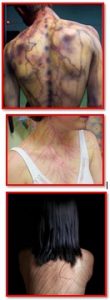THUNDER STRIKE
THUNDER STRIKE
A lightning strike (fulguratio) occurs due to a sudden and strong discharge of electricity between the clouds and the ground. In essence, it is a direct current shock of enormous energy.
Lightning strikes can be direct or indirect. Direct occurs usually when a person carries metal objects outdoors during thunderstorms, while indirect usually occurs when direct current passes through a tree and passes through the victim into the ground.

Symptoms and signs of lightning strikes
Rani
-various heart rhythm disorders
-cardiac arrest
-breathing arrest
-loss of consciousness
-convulsions (cramps)
-impossibility of remembering the events that preceded the lightning strike
-coma
-burns of various shapes, typical like ferns, carbonization (charring) of the body is also possible.
- injuries of the chest and abdomen, bone fractures, eye and ear injuries (rupture of the eardrum in 50% of cases bilaterally).
Late signs
-memory loss, sleep disturbance, anxiety.

Lightning strike procedure:
- call an ambulance immediately
- The basic rule is "do not increase the number of victims". The rescuer must assess, taking into account his own safety, whether it is possible to move the victim to a safer place.
-the victim of a lightning strike can be immediately approached and touched without danger
-assess the state of consciousness, pulse, respiration, and if necessary immediately begin resuscitation measures (think of a possible spinal cord injury). Resuscitation should be persistent and long-lasting because paralysis of the respiratory muscles can last for a long time. When there are more victims, those who need to be resuscitated always have the advantage in care.
-
- place the unconscious victim in a lateral position
- take care of other injuries (fractures, wounds and burns).
-every victim of a lightning strike should be taken to hospital with constant monitoring of vital functions and psychological support to the victim.

The risk of lightning strikes can be avoided by following these rules:
-do not stand by windows, open doors, metal poles, power lines, cable and transmission line poles, and items such as faucets, sockets and electrical switches
-do not use your phone and mobile phone during a storm, and avoid carrying metal objects
-switch off all electrical appliances during a storm
- never stand in a large group of people, so that in the event of a lightning strike it affects fewer people
-avoid lonely trees or forest edges, and seek shelter near smaller trees and shrubs
-in the open space, choose the lowest places, where there is no water, squat and bend forward and cover your ears with your hands to prevent injuries to the eardrum.
